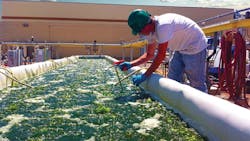Expansion Management: Heliae's Future Cash Crop: Algae
There is no greater satisfaction than being able to strategically analyze a problem, create a solution and see that solution through to commercial fruition. This is exactly what the leaders of Mars Inc. have been able to accomplish. As a privately-held family company whose horizon is 20 years into the future, the management team surveyed the manufacturing landscape to determine what opportunities were ahead based on global constraints.
See Also: Manufacturing Plant Site Location Strategies
The company realized the mounting importance of securing clean water and energy as well as maintaining fertile soil plus the desire for marine-based nutrition. There was one source that could address all of these issues -- algae.
Deciding how to farm algae for commercial applications led one of the company leaders, Frank Mars, to Arizona State University, the location of the Arizona Center for Algae Technology and Innovation (AzCATI).
AzCATI was created by grants from the Science Foundation Arizona. The algae industry in general had support from the state in the form of two algae-related bills passed classifying algae as agriculture and allowing for the growth and harvest of algae on state trust lands.
"I can safely say that none of us would be here without the combined vision of Frank Mars, one of our founders, and Bill Harris of the Science Foundation Arizona,"said Heliae's CEO Dan Simon at the May 2012 groundbreaking of the company's commercial demonstration facility.
Heliae, which began as an incubated tech startup on the campus of Arizona State University, was founded on the premise that algae can provide value in a number of markets if the right technology platform is devised to enable commercialization.
The company was officially founded in 2008 and by 2012 had created a process which can help companies convert sunlight and industrial waste streams into affordable, renewable food and drop-in transportation fuels.
The company's new demonstration facility develops and designs the technology that enables sustainable industrial-scale production of food, fuel and biochemicals from algae.
"While we can serve a variety of industries, we are focusing first on the highest value sectors like personal care and nutraceutical markets, where we already have products on the shelf or for sale as ingredients," explains Nick Donowitz, director of corporate development.
The next two markets the company will tackle are therapeutics and agricultural systems including fertilizer.
As the company grew from 20 employees in 2010 to 85 in 2012 and needed more space, it chose Gilbert, Ariz., due to available land, a business-friendly environment and the desire of the community to create a technology cluster. Gilbert also offered the advantage of enabling the company to open its demonstration facility adjacent to its research facility. The company forecasts employing more than 140 by 2014. It is able to draw upon its association both with ASU and the University of Arizona to attract employees with the skills it needs.
Educated employees are a resource that Arizona has been developing. "We realize how important a highly-skilled workforce, with the ability to adapt to rapidly changing technologies, is to our science, technology, engineering and mathematics (STEM) business anchors," says Gilbert Mayor John Lewis. "In Gilbert we are collaborating with educational institutions and regional and state organizations to ensure our businesses have a diversely skilled and talented workforce."
The strength of Heliae's workforce is reflected in the firm's ability to secure patents. As Heliae expands the application of its technology platform, the company has been collecting patents. Within the past 18 months it has been awarded 50 patents with a pipeline of 300 pending. "We are in second place in terms of global IP for algae," explains Donowitz.
Connecting researchers and businesses to develop commercial endeavors is a business model Arizona has been using successfully. Through the Science Foundation of Arizona, every dollar in funding has brought in $4.40 from industry and other sources. According to the Battelle Institute, these leveraged funds are just the beginning of a multiplier effect that "results in new wealth for Arizona."
Heliae would agree with the potential. "Of the 100,000 strains of algae, humans consume only a few. We have barely scratched the surface of what's possible with these organisms," enthuses Donowitz.

